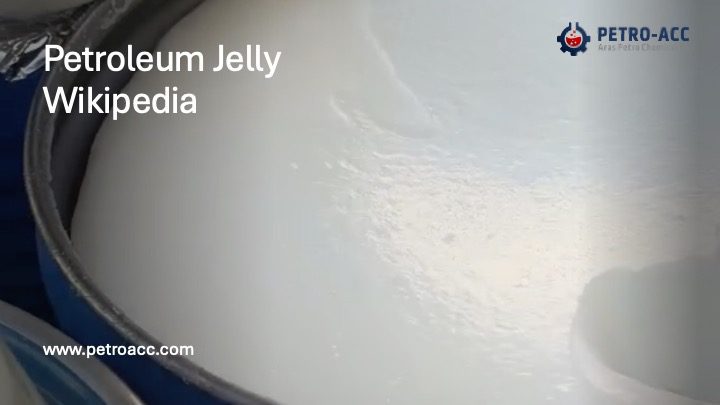Petroleum jelly (also known by the brand name Vaseline) is a semi-solid mixture of hydrocarbons derived from petroleum (crude oil). It’s a smooth, oily substance that’s used mainly for its moisturizing, protective, and healing properties.
Here’s a breakdown of what it is and how it works:
🔬 Composition
- Made up mostly of long-chain saturated hydrocarbons (like paraffin and microcrystalline waxes).
- It’s refined and purified to remove any harmful residues or impurities found in raw petroleum.
💧 Properties
- Water-repellent: Forms a barrier on the skin that locks in moisture and protects against irritants.
- Colorless to pale yellow, depending on the level of refinement.
- Odorless and tasteless when fully purified.
🩹 Common Uses
- Skin care: Prevents dryness, chapping, and minor irritation.
- Wound protection: Helps minor cuts and burns heal by keeping them moist and protected.
- Lips: Used as lip balm to prevent chapping.
- Baby care: Protects against diaper rash.
- Cosmetics and pharmaceuticals: Acts as a base or carrier for other ingredients.
⚠️ Safety Notes
- Pure, USP-grade petroleum jelly is safe for external use.
- It should not be ingested or used inside the nose or on deep wounds.
- Always ensure it’s fully refined and labeled for cosmetic or medical use — unrefined petroleum products can contain harmful impurities.
How it’s made from crude oil
Great question — here’s a clear, step-by-step look at how petroleum jelly is made from crude oil
🛢️ 1. Starting with Crude Oil
Crude oil is a complex mixture of hydrocarbons — molecules made of hydrogen and carbon — along with trace elements of sulfur, nitrogen, and oxygen.
Before petroleum jelly can be made, the oil must go through refining, a process that separates crude oil into various useful fractions.
⚗️ 2. Fractional Distillation
In a refinery, crude oil is heated in a fractionating column. As it vaporizes and rises through the column:
- Lighter fractions (like gasoline and kerosene) boil off first.
- Heavier fractions (like lubricating oils, waxes, and residues) remain near the bottom.
Petroleum jelly comes from these heavier, waxy oil fractions.
🧪 3. Dewaxing and Filtering
The heavy oil fraction contains both oil and wax components.
Refiners cool and filter the mixture to separate out the waxy material that will form the base of petroleum jelly.
This step may include:
- Chilling to solidify waxes.
- Filtration or centrifugation to remove excess oil.
🧼 4. Purification and Refining
This is the most critical stage — it transforms the raw petroleum residue into a safe, clean jelly.
Refining involves:
- Distillation under vacuum to remove volatile impurities.
- Chemical treatments (using sulfuric acid, clay, or hydrogenation) to remove color, odor, and contaminants such as polycyclic aromatic hydrocarbons (PAHs).
- Filtration through activated charcoal or bleaching earth for final purification.
After this process, the material becomes colorless, odorless, and stable — suitable for cosmetic and medical use.
🧴 5. Blending and Finishing
Finally, the purified waxes and oils are blended in specific ratios to achieve the desired consistency — semi-solid, smooth, and non-greasy.
The product is cooled, tested for purity, and then packaged as petroleum jelly (e.g., Vaseline®).
✅ End Product
The result is a highly refined hydrocarbon gel with:
- Excellent moisture-sealing properties
- High chemical stability
- Very long shelf life
Simple flow chart showing how petroleum jelly is made from crude oil:
🛢️ Crude Oil
│
▼
⚗️ Fractional Distillation
(separates heavy oil fractions)
│
▼
❄️ Dewaxing & Filtration
(remove excess oil & isolate waxy base)
│
▼
🧪 Purification & Refining
- Remove color, odor, impurities
- Hydrogenation / filtration / bleaching
│
▼
🧴 Blending & Cooling
(adjust texture and consistency)
│
▼
✅ Petroleum Jelly
(colorless, odorless, skin-safe)
Applications of Petroleum Jelly:
🩺 1. Medical and First Aid Uses
Petroleum jelly is widely used in healthcare because it protects and promotes healing.
Examples:
- Wound care: Covers minor cuts, scrapes, and burns to keep them moist and prevent infection.
- Post-surgery protection: Keeps stitches and healing skin hydrated, reducing scarring.
- Preventing diaper rash: Forms a barrier on babies’ skin to protect from moisture and irritation.
- Preventing chafing: Used on areas prone to friction (thighs, underarms, heels).
- Lip care: Treats cracked or dry lips by sealing in moisture.
💄 2. Cosmetic and Skin Care Uses
Petroleum jelly is a common base ingredient in many beauty and skincare products.
Examples:
- Moisturizer: Applied on dry areas (hands, elbows, knees) to soften skin.
- Makeup remover: Gently dissolves makeup, including waterproof mascara.
- Eyebrow and eyelash conditioner: Adds shine and smoothness.
- Cuticle softener: Helps keep nails and cuticles hydrated.
- Highlighter substitute: Adds a natural glow to cheekbones or lips.
🧰 3. Industrial and Technical Uses
Because it’s chemically stable and water-repellent, petroleum jelly also has technical applications.
Examples:
- Lubricant: For hinges, machinery parts, zippers, and battery terminals.
- Rust prevention: Protects metal tools or surfaces from corrosion.
- Sealant: Used in electrical and plumbing work for waterproofing joints.
🏠 4. Household Uses
Petroleum jelly is handy for everyday home uses.
Examples:
- Preventing stuck lids: Rub a small amount on jar threads to keep lids from sticking.
- Protecting skin from hair dye or nail polish stains.
- Polishing shoes and leather goods.
- Preventing squeaky doors or drawers.
🐾 5. Veterinary Uses
- Pet paw protection: Shields paws from salt, snow, or rough surfaces.
- Minor skin irritations: Helps soothe small scrapes or dryness in animals (with vet approval).
How it helps heal skin:
Understanding how petroleum jelly helps the skin heal explains why it’s been a skincare staple for over a century.
Here is the science behind it:
🧴 1. It Creates a Protective Barrier
Petroleum jelly is occlusive, meaning it forms a thin, protective layer on the surface of the skin.
- This barrier locks in moisture and shields wounds or dry areas from air, bacteria, and friction.
- By preventing the skin from drying out, it gives your body’s natural healing processes a stable environment to work in.
💡 Fun fact: Studies show that wounds kept moist and covered heal faster and with less scarring than those left open to the air.
💧 2. It Prevents Water Loss (Transepidermal Water Loss)
Your skin constantly loses small amounts of water — called transepidermal water loss (TEWL).
Petroleum jelly can reduce TEWL by up to 99%, helping the outer layer of skin (the stratum corneum) stay hydrated and flexible.
This helps:
- Soothe dry, flaky, or cracked skin
- Maintain the skin’s natural barrier function
- Reduce itching and irritation
🧬 3. It Supports Natural Repair
When the skin is injured — from a cut, scrape, or burn — your body needs moisture to:
- Move repair cells into the wound area
- Promote collagen formation
- Build new tissue
By keeping the area moist and protected, petroleum jelly:
- Speeds up healing
- Reduces the risk of scab formation and scarring
- Prevents contamination from dirt and microbes
🛡️ 4. It’s Chemically Inert and Hypoallergenic
Pure petroleum jelly (USP-grade) is:
- Non-comedogenic (won’t clog pores)
- Hypoallergenic (rarely causes allergic reactions)
- Chemically stable — it doesn’t react with skin or medications
That’s why it’s used safely even on:
- Newborn skin (for diaper rash)
- Sensitive areas (like lips or eyelids)
- Minor wounds and post-surgical sites
🚫 What It Doesn’t Do
Petroleum jelly doesn’t add moisture it seals in the moisture that’s already there.
So, for best results, apply it to slightly damp skin (e.g., right after a bath or washing your hands).




Leave A Comment